The Eternal Flame of Chestnut Ridge Park: an unexplained origin?
An eternal flame is a flame burning continuously over an indefinite period
of time. Eternal flames can be man-made, so they serve commemorative or
religious purposes. But a number of eternal flames are also naturally
occurring, some of them burning for centuries or even thousands of years
without a break.
 |
| [This picture is collected from Wikimedia Commons which is licensed under CC BY-SA 3.0] |
As for the modern eternal flames, present in many cities around the world, they are generally powered automatically by propane or natural gas supplies.
There are also many natural eternal flames, some of which have long defied scientists.
These natural flames are generally fueled by natural sources of gas, peatland fires or coal seam fires. The flame can be initially ignited by lightning due to thunderstorms, by a piezoelectric effect or by humans.
The Fall of the Eternal Flame of Chestnut Ridge Park: a natural Eternal Flame of unexplained origin
A notorious example of a natural Eternal Flame is that of Chestnut Ridge Park in New York, in a place known as "Eternal Flame Falls".
It is a small cave located behind a waterfall from which escapes a combination of natural gases that can be ignited to produce a small continuous flame. Although testimonies trace the first ignition back several hundred years, the flame has been extinguished and re-ignited a number of times.
In 2013, geologists from Bloomington University (Indiana) and the Italian National Institute of Geophysics and Volcanology studied the site in detail to measure the contribution of this hydrocarbon leak to the local greenhouse effect.
Measurements revealed higher concentrations of ethane and propane (around 35%) than at any other known natural site, which usually contains a high proportion of methane. They estimated that the gas leak emits approximately 1 kg of methane per day.
In addition to the main leak, the researchers identified several other micro-leaks; by comparing the gases emitted by these with those from other nearby sources, they determined that the gases came from the Rhinestreet Shale, a shale structure located 400m deep. Tectonic activity has certainly fractured the shale, allowing gases to escape to the surface.
Usually, however, shale must reach a temperature of around 100 ° C for its carbon structure to fracture and allow gas molecules to fragment. However, the Chestnut Ridge shale is cooler and younger than the shale formations that typically originate this shale gas. This suggests the additional action of a still unknown mechanism, which would allow the fracturing of the shale at low temperatures. The researchers hypothesized a dual interface catalytic mechanism.
Natural eternal flames across the world
Apart from Eternal Flame Falls, geologists have reported several other sites around the world where natural Eternal Flames can be seen.
Near the village of Darweze, Turkmenistan is the gas crater of Darvaza. This is a collapsed natural gas field that geologists ignited in 1971 to prevent toxic methane leaks. This site, known locally as the "Gateway to Hell" has been burning continuously since 1971.
Near the city of Baku, the capital of Azerbaijan, a natural fire has been burning continuously from a release of natural gas since 1950, when it was accidentally lit by a shepherd.
Called Yanar Dag, this site, which is part of a mud volcano, is the source of flames of up to three meters, released by tiny cracks in the sandstone layer of the rock structure.
The cause of this permanent fire is an oil leak from porous strata located at depth.
The Yanartas site in Turkey is the site of several eternal flames. These escape from the mountain slopes within an area of 5000 m².
Natural leaks of methane (87%), hydrogen (7-11%), nitrogen (2-4%), alkanes (0.5%), carbon dioxide (0.01-0.07%) and helium (80 ppmv) are at the origin of these flames which have been burning for 2,500 years; this is the largest release of a biogenic methane on land. The intensity of the flames changes with the seasons because the gas emissions are modulated by atmospheric pressure.
Beyond the natural eternal flames fueled by gas, there are also such phenomena fueled by seams of coal. The best-known example is the "Burning Mountain", a hill near the town of Wingen in Australia. The flames are fed by a permanent underground fire, located 30m deep, from the natural ignition of a network of coal seams. Data acquired by scientists suggests that this fire has been burning for at least 6,000 years.






0 Comments